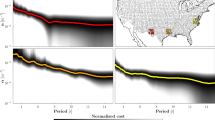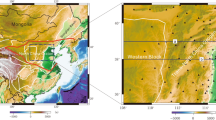Abstract
THE Tibetan Plateau, which has an average elevation of 5.0 km over 7×105 km2, is the largest topographic mass above sea-level on the Earth. Because it is covered with Cretaceous limestones1 its uplift must be Tertiary, and is probably related to the Himalayan continental collision. There is considerable debate concerning its present structure and mode of formation. Various authors have theorised that Tibet was uplifted by underthrusting of a second crustal layer2–6; by horizontal compression and thickening7–9, or by low-density material in the mantle10. All that is known with certainty is that it is isostatically compensated11, and covered with widespread Neogene calc-alkaline volcanic rocks12. The study of Rayleigh wave attenuation reported here indicates that the lowermost part of the crust is partially molten, and that uplift has been due to horizontal compression.
This is a preview of subscription content, access via your institution
Access options
Subscribe to this journal
Receive 51 print issues and online access
$199.00 per year
only $3.90 per issue
Buy this article
- Purchase on Springer Link
- Instant access to full article PDF
Prices may be subject to local taxes which are calculated during checkout
Similar content being viewed by others
References
Hennig, A. Southern Tibet: Discoveries in Former Times Compared with My Own Researches in 1906–1908, 5 (1915).
Argand, E. C. R. Thirteenth Int. Geol. Congr. 1, part5, 171–372 (1924).
Carey, S. W. Proc. R. Soc. Tasmania 89, 255–288 (1955).
Holmes, A. Principles of Physical Geology (Nelson, London, 1965).
Powell, C. M. & Conaghan, P. J. Earth planet. Sci. Lett. 20, 1–12 (1973).
Powell, C. M. & Conaghan, P. J. Geol. 3, 727–731 (1975).
Dewey, J. F. & Bird, J. M. J. geophys. Res. 75, 2625–2647 (1970).
Dewey, J. F. & Burke, K. C. A. J. Geol. 81, 683–692 (1973).
Toksöz, M. N. & Bird, P. Tectonophysics (in the press).
Molnar, P. & Tapponnier, P. Science 189, 419–426 (1975).
Ambolt, N. Reports from the Scientific Expedition to the N.W. Provinces of China under the Leadership of Dr. Sven Hedin, 2, (1948).
Kidd, W. S. F. EOS Trans. Am. geophys. Un. 56, 453 (1975).
Tandon, A. N. & Chaudhury, H. M. Ind. J. Met. Geophys. 15, 467–474 (1964).
Tung, J. P. & Teng, T. Univ. S. Cal. Geophys. Lab. Technique. Rep. no. 74–2 (Los Angeles, 1974).
Boore, D. M. J. geophys. Res. 75, 1512–1527 (1970).
Lee, W. B. & Solomon, S. C. Geophys. J. R. astr. Soc. 43, 41–71 (1975).
Woollard, G. P. J. geophys. Res. 64, 1521–1544 (1959).
Dziewonski, A., Bloch, S. & Landisman, M. Bull. seism. Soc. Am. 59, 427–444 (1969).
Author information
Authors and Affiliations
Rights and permissions
About this article
Cite this article
BIRD, P., TOKSÖZ, M. Strong attenuation of Rayleigh waves in Tibet. Nature 266, 161–163 (1977). https://doi.org/10.1038/266161a0
Received:
Accepted:
Issue Date:
DOI: https://doi.org/10.1038/266161a0
This article is cited by
Comments
By submitting a comment you agree to abide by our Terms and Community Guidelines. If you find something abusive or that does not comply with our terms or guidelines please flag it as inappropriate.



